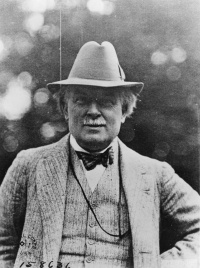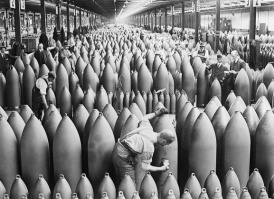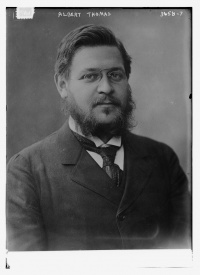Pre-war Expectations of Shell Consumption↑
In the last decade of the 19th century, artillery firepower was revolutionized. Steel field guns of larger calibres could range up to seven kilometres. Smokeless powder meant gunners could see to identify their targets. The remaining problem was that of recoil: the discharge of the shell caused the whole gun to move, and it had to be relaid for each round. The solution was for the barrel to move while the gun’s carriage remained stationary. Brakes checked the recoil and springs forced the barrel back to its original position. Crews could now stay close to the gun’s breech, sheltering behind its shield. In 1897, the French army adopted the war’s most effective quick-firing field gun, the 75mm, capable of firing twenty rounds a minute. In the following decade, the other European armies raced to match it. They recognized that previous calculations of shell consumption were now outdated, revising their expectations on the basis of the wars fought after 1899. By 1914, most had doubled their stocks, holding between 1,000 and 1,500 rounds per gun, thought to be enough for about six months’ fighting. Larger quantities in peacetime created the danger of obsolescence: crucial now was the speed at which munitions industries could be converted to wartime production.
The Causes of Shell Shortage↑
In 1914, shell shortage emerged more quickly than anticipated – for France within six weeks, during the battle of the Marne, and for other armies, including the British and German, by November. The shortening of the day and the worsening of the weather as winter approached then provided some respite. In August, it had been assumed that the initial control on shell consumption would be not output, but transport. In manoeuvre warfare, artillery batteries were limited to the shells they could carry in their gun limbers or could draw from immediate sources of resupply. The development of trench warfare stabilized armies’ lines of communication while increasing the number of available targets. So as guns expended more shells, their demands were relayed all the way back to the factories. The problem was compounded because the need to destroy field fortifications rather than kill infantry crossing open ground created additional and different demands - for heavier artillery, whose manufacture was much more complex, and for high-explosive shells, not the shrapnel or fragmentation shells on which pre-war plans had rested.
The Conversion of Industry to War Production↑
Pre-war production was overwhelmingly vested in government factories. They met the limited demand for shells while maintaining quality control. The first need on the war’s outbreak was to widen the sources of production to private industry. Firms required reassurance that converting plants would be worthwhile, and so governments loaded them with orders which guaranteed their profits. However, the industry lacked both machine tools and skilled manpower, especially as conscription had taken so many men, and unfulfilled orders accumulated. The Central Powers, cut off from overseas supplies, worried about raw materials, especially nitrates for explosives and copper for the driving bands of shells. Quality became subordinated to quantity in the bid to satisfy demand: France made shells in two parts to simplify production and Germany exploited pre-war research to replace steel with cast iron. As a result, shells could explode prematurely in the barrel, destroying the gun and killing the crew, or fail to explode at all.
The Political Ramifications↑
In the winter of 1914-1915, every belligerent confronted shell shortage to varying degrees. A military problem, which could have been alleviated by tactical solutions, became an industrial one, and then a political one. Generals rationalized their own failures by saying they could only break the enemy line if they had enough guns and shells. They were not wrong. This was an artillery war, but by increasing the length of bombardments they exacerbated the problem. They turned the spotlight on politicians, pushing them to challenge the workings of the free market. In May 1915, the British liberal government fell in part because it had failed to deliver sufficient shells, and its successor established a ministry of munitions under David Lloyd George (1863-1945). France appointed the socialist politician Albert Thomas (1878-1932) to a comparable job, albeit still situated within the ministry of war. Both states worked with private industry to meet national targets. In Russia, businessmen created a war industries committee, but the government was reluctant to cooperate. The Prussian war ministry set up a raw material agency at the war’s outset, but did not address munitions production directly until confronted, in September 1916, with the so-called "Hindenburg Programme". Although it created a weapons and munitions procurement agency, Germany never resolved the tension between collectivism and the free market, and never established an independent and all-encompassing ministry for munitions.
Hew Strachan, University of St Andrews
Section Editor: Jennifer Wellington
Selected Bibliography
- Feldman, Gerald D.: Army, industry, and labor in Germany, 1914-1918, Princeton 1966: Princeton University Press.
- Godfrey, John F.: Capitalism at war. Industrial policy and bureaucracy in France, 1914-1918, New York 1987: Berg; St. Martin's Press.
- Siegelbaum, Lewis H.: The politics of industrial mobilization in Russia, 1914-17. A study of the war-industries committees, New York 1983: St. Martin's Press.
- Strachan, Hew: The First World War. To arms, volume 1, Oxford 2001: Oxford University Press.
- Wegs, J. Robert: Die österreichische Kriegswirtschaft 1914-1918, Vienna 1979: Schendl.
- Weyrauch, Robert: Waffen- und Munitionswesen, Berlin 1922: De Gruyter.











